GLG
362/598 Geomorphology
Mass Wasting processes
Large quantities of material are set im motion all at once. (as opposed
to other processes in which individual particles are entrained and thus
have a low concentration).
For mass wasting, the medium is not important versus wind and water
for aeolian and fluvial processes.
We consider the effect of gravity directly on the particles rather
than its effect through the transporting medium.
Initial classification:
| Production-limited |
Transport-limited |
| Transport rate depends on materials and may exceed that available from
the regolith. So we end up with thin or no regolith and threshold
angles (above which failure occurs are importnat). Rockfalls are
an example of this type of mass wasting process |
Transport rate depends on external force. Production rate > erosion
rate from transport so we have thick regolith. Creep is an example
of this type of mass wasting process. |
Another classification:
Creep/Heave vs. Flow vs. Slide. See Figure 4.26 from Ritter, et al.
Most processes are some combination of these three.
One movement may begin as one process and change as time passes, conditions
change, or slope changes.
Creep and heave
Creep-slow, nearly imperceptible downslip of soil debris.
Continuous (gravity) or seasonal (raindrop impact,
depth of motion limited to depth of penetration of weakening effect).
Reduction of cohesion or strength of material.
Mass transport rate is usually proportional to local slope.
Seasonal example: Frost heaving
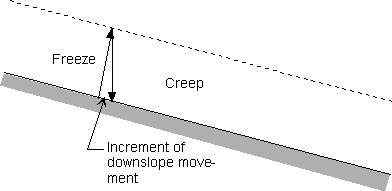
Slope dependent and moisture
content dependent: more heave; lower cohesion; depth of penetration
or mobile layer important.
Continuous creep
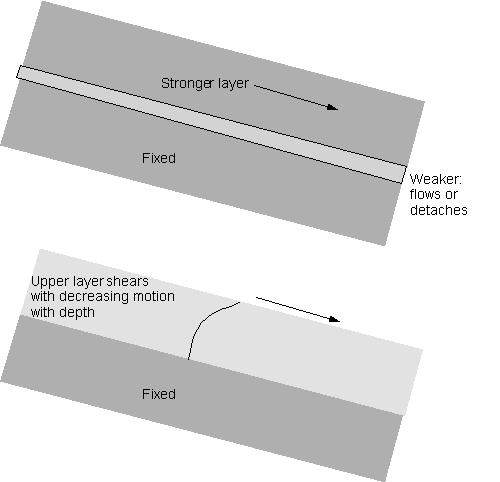
Not restricted to unconsolidated material. Could be soil or could
be blocky material.
See figures 4.27, 4.28, and 4.30 from Ritter, et al.
Solifluction
Humid climate, spring snowmelt
Gelifluction
periglacial
Similar to continuous creep above. Material is water saturated,
but does not completely detach or flow but "sags" downhill.
Slides
Bedrock or soil material and needs a shear plane (detachment surface).
See figure 4.33 from Ritter. Its source is a classic (Varnes, 1958).
See also figure from Pewe for a local example.
Well known associations of slides with various characteristics:
fine-grained porous materials.
Soluble or structurally weak.
Weathering state: deep chemical weathering
Disposition of strata:
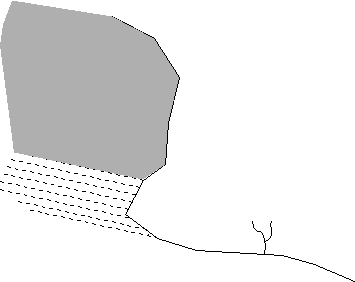
Examples
Blackhawk slide reference is from Shreve, 1968. The Blackhawk Landslide.
Geological Society of America Special Paper 108.
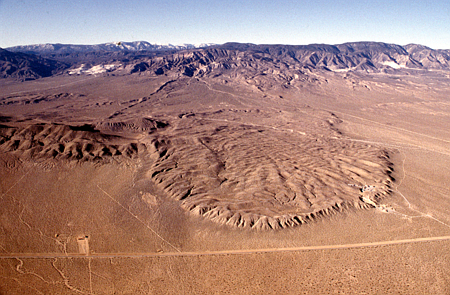
The Blackhawk Landslide, San Bernardino County, CA. Photo: Kerry
Sieh
Blackhawk cross-section.

Overheads:
Blackhawk oblique from
Chuang and Greeley, 2000, Large mass movements
on Callisto, Journal of Geophysical Research, v. 105, p. 20,227-20,244.
Blawkhawk vertical from Fairchild collection
Blawkhawk vs. other slides and speed from Shreve, 1968.
Emplacement mechanisms
Sometimes these slides turn into dry rock avalanche (or sturstrom "rock
storm"). Much material is flowing but in a dry matrix. These
flows have very high velocities.

Mt. Huascaran, Peru (1970) 106 m3, slid 4 km at
280 to 400 km/hr:
How do these flows travel so far over low slopes?
Blackhawk emplacement was inferred to be accomodated by an air blanket
beneath the slide (assumes that the slide material has very low permeability).
Air blanket flows out the sides and then the slide stopped at the front,
decelerating upslope and producing the transverse or arrest ridges.
Important evidence for the air blanket hypothesis is that some flows have
been over snow without disruption and observations of massive air blasts.
Another hypothesis was put out by Hsu in 1975 based upon observations
of the Elm slide in Switzerland and further developed by Melosh.
Flow resistance is reduce by acoustic fluidization of the granular
material. Kinetic energy (vibration) of grains of material so great
as to cause fluidization. No great mixing (material in front stays
in front). This is an important alternative because of extraterrestrial
slides such as large Martian ones (in Gangis Chasm: 120 km movement
wiht no air cushion possible). Also our Callisto example would fit
this explanation. This kind of flow is similar to one called grainflow
by Bagnold.
In comparison with volcanic features (especially pyroclastic flows),
heat and degassing are also important in the decrease in flow resistance.
Debris flow or debris avalanche
Unconsolidated debris at the surface rather than bedrock. Commonly associated with massive rainfalls. Move as turbulent flows. Don't go as fast or as far as rock avalanches
Likely circumstances:
Steep slopes
Thick cover of unconsolidated material
Heavy rain
Channelized

Debris flow at Tahoma Creek (Mt. Ranier), July 26, 1988.
Earthflows
Slow flows that are unsaturated (less than 10 percent water). Move relatively slow (hours to days). Unchannelized. May have arcuate scarp at head and lobate toe. Common in humid climates. Slow moving, seasonally reactivated. Often permeable materials over impermeable.
Slumgullion Colorado Earthflow
Small earthflow in roadcut in North Dakota:
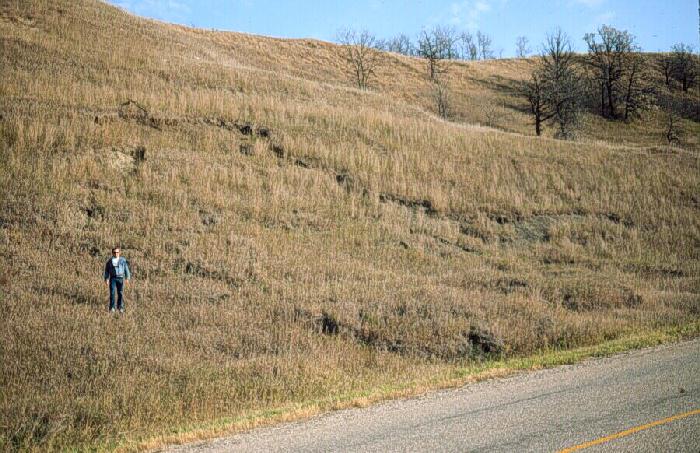
Mudflows
Flowing masses of fine-grained material with high fluidity. Much water (up to 60 percent). Much fine grained material (clay size in particular).
Conditions favoring:
Steep slopes
Channelization
Abundant fine grained material
Relatively sparse vegetation
Seasonally high water content
Alpine and semi arid environs and volcanic areas (lahars)
Velocities may be up to 100 km/hr. THey move in surges.
House damaged by Mt. St. Helens mudflow
Rotational slides/slumps
See overall structure of Rotational slide (Figure 4.34 from Ritter, et
al.). These are usually formed above curved surfaces of failure with
intermittent movement commonly involving backward rotation of the rock.
Other examples of slides, some fast and some slow.
Las Colinas, El Salvador landslide, 2001
Location
Overview
Big slide
More slides
Bitterwater Creek, CA Landslide
Hawaii (Naka, et al., 2000, Tectono-magmatic processes investigated
at deep-water flanks of Hawaiian volcanoes, EOS, v. 81, p. 221.
Hebgen Lake slide, Montana--Photos
Big Rock Mesa (BRM) landslide, California (Shuirman and
Slosson, 1992, Malibu Landslide: massive litigation; Chapter 3 in
Forensic engineering: environmental case histories for civil engineers
and geologists, San Diego, CA, Academic Press, p. 18-84. See Mimi Diaz graduate presentation.
Large Mass movements on Callisto--Chuang and Greeley. See reference above.
Black
Canyon City landslide (we will see it later this semester).
La Conchita Landslide--if there is time.
Page last modified October 17, 2002 by Ramón
Arrowsmith




